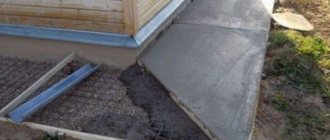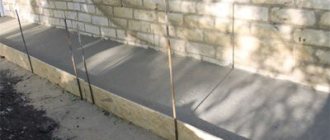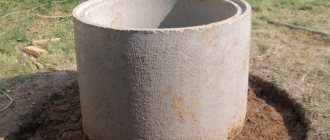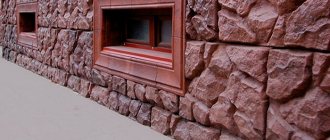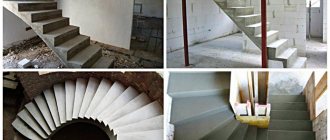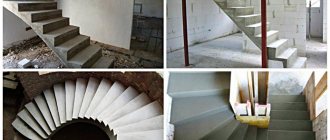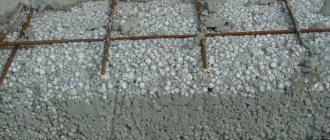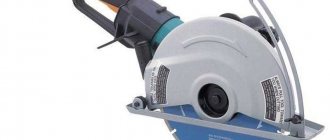Blind areas have two functions - decorative and protective. If the first usually does not pose any difficulties, the second is not so easy to organize. In order for a concrete blind area to be a good addition to the thermal and waterproofing of the foundation, protecting it from aggressive substances in soils and mold, it must be done correctly. This is discussed further below.
What does it represent?
The blind area is an external basement waterproof concrete structure in the form of a continuous path along the perimeter of the building, sloping from the wall towards the surrounding topography of the local area. Its arrangement involves a tight but movable connection to the base of the house.
The structure is a layered “pie” consisting of materials that together keep the foundation dry. The basis of such protection is in proportion: a compacted, even underlying layer of sand (crushed stone, clay), waterproofing and a coating - concrete, which ensures the waterproofness of the structure.
Return to contents
Possible types of structures, necessary tools
What does the scheme for constructing a blind area look like:
- Ditch formation stage;
- Creation of the so-called shock-absorbing pillow. It includes layers of sand and crushed stone;
- Installation of prepared reinforcing bars for a concrete frame;
- Directly the pouring stage;
- Final finishing work.
There are several types of blind areas depending on the characteristics listed below:
- Possible service life;
- Design features;
- Materials used in the construction process.
Depending on the listed characteristics, the following types of blind areas can be distinguished:
- Soft type;
- Hard type;
- Semi-rigid type.
Moreover, each of the identified types has its own characteristics, as well as arrangement technology.
Blind area options
Functions performed
A properly equipped blind area ensures the longevity of the structure, preventing the destruction of the foundation and structures of the house by moisture from precipitation and melt water. A blind area without concrete, created with your own hands, is a temporary measure that does not solve the entire complex of problems of such a design.
The main function of a proper blind area is to drain and transport water a sufficient distance from the foundation towards the lowest place on the site or into a storm drain.
In addition to the function of a horizontal hydrobarrier, the blind area (especially insulated) reduces the freezing of the soil around the house, which reduces the likelihood of it swelling (rising), and also reduces the thermal conductivity of the building. A blind area without concrete does not prevent periodic moisture of the soil close to the foundation and, as a result, the harmful effects that hard plant roots can cause to it. The protective device also gives the building an aesthetically complete appearance and can be used as a pedestrian path.
Return to contents
Why is it needed?
The installation of a concrete blind area around the house is a hydraulic barrier for the foundation. The design creates comfortable indoor conditions, preventing the penetration of moisture. In addition to this factor, the foundation of the structure is negatively affected by sub-zero temperatures and mechanical deformations due to soil mobility. A completed embankment without pouring mortar does not interfere with the passage of water; it is also destroyed by the germination of the root system of trees and shrubs. A concrete blind area, in addition to its protective function, can decorate a personal plot with the help of decorative paving slabs. Its production is regulated by SNiP 2.02.01-83.
The main task performed by a blind area around a concrete house is to drain sediment and groundwater at a sufficient distance from the base of the building into a storm drain or into a low-lying area of the garden area.
View “SNiP 2.02.01-83” or
Requirements for the blind area and design rules
Diagram of a structure using reinforced concrete.
The encircling protective structure must have the same width, the value of which is 20–30 cm greater than the overhang of the roof eaves beyond the wall of the building. It is generally accepted that it is about 1 m (or more on subsiding soils). The blind area is buried to no more than half the depth of soil freezing in the area. The thickness of the concrete coating is selected within the range of 7 - 10 cm (up to 15 cm if used as a path).
The recommended slope of the coating is 92 - 94 degrees relative to the wall of the building (or 10 - 100 mm per 1 meter of blind area width). The height of the base above the blind area at the junction of the structure is set to 50 cm. Its outer lower edge should be raised approximately 50 mm above ground level, which prevents the accumulation of water at the edge. The technology for creating a structure assumes the possibility of its integral movement following soil deformations relative to the foundation, which provides a wall expansion joint.
Return to contents
Formwork
The formwork can be installed immediately after excavation - then the sand and gravel will be compacted in it. In the example, the formwork is installed using a ready-made “cushion”.
Step-by-step instructions for formwork will be as follows:
- Mark the area using a cord (you can use the markings made when excavating the earth).
- Install wooden pegs around the perimeter (outside the cord) at intervals of 1.5–2 m.
- Install the sides of the formwork between the cord and the pegs - they can be screwed on with self-tapping screws or nailed. The horizontal position of the sides and the consistency of the slope are controlled using a building level.
It makes sense to strengthen the junctions of the boards with the pegs and the corners of the formwork from the outside - using wooden or metal “corners”.
How to make a blind area?
Markings are made on the area, the fertile layer of soil is removed. An underlying layer of sand (clay) is laid. Geotextiles (for example, roofing felt) are laid. The formwork is formed taking into account expansion joints. The area filled with concrete is reinforced. Concrete for the blind area is prepared in the correct proportion and poured into the formwork. The coating surface is drawn out with the selected slope along the edge of the formwork and leveled. The concrete is given time to dry.
Return to contents
Preparation of tools and materials
The quality of the markings is checked by the building level.
For excavation work you will need shovels, a pick, twine, tape measure, rammer, and pegs. The required volume of geotextile (waterproof film) for the water seal should be calculated. The required quantity and proportions of components for mixing concrete (washed sand, water, gravel, crushed stone of fractions 5 - 10 mm, cement) or a ready-mixed concrete (for example, grade M400 and higher) are required. Tools also include a mixer (container) for forming the solution, shovels, buckets, carts (stretchers), and a measuring bucket. The laying of the underlying layer must be provided with sufficient sand (clay).
The formwork is formed from boards, but a hacksaw, level, nails, and hammer are also useful. Reinforcement is performed with steel mesh (steel wire), which should be delivered. You will need a welding machine and a tool for cutting pieces of reinforcement. A long rule, trowel, and spatulas will help in laying and leveling concrete. The construction of seams will require polyurethane sealant.
Return to contents
Marking
A trench is marked around the house with pegs and string. The level at which the blind area adjoins the plinth is marked with beacons in 1.5 m increments. A layer of fertile soil is removed around the building, taking into account the layout of the surrounding surface. The bottom of the trench is compacted and leveled with the already formed slope (herbicides can be added). The depth of the passage can be 500 mm (on heaving soils).
Return to contents
Creation and compaction of a sand cushion
The bottom of the trench is lined with sand, the surface of which is also profiled with a slope. The material is abundantly moistened and compacted. The operation should be repeated at least twice. The thickness of the layer can be up to 20 cm. Its surface is carefully leveled.
Return to contents
Waterproofing
The use of rolled waterproofing materials for blind areas.
Its device involves laying two layers of waterproofing (for example, roofing felt) on a sand substrate, which are slightly folded onto the wall to create an expansion joint. At the joints the material is overlapped. Next, the geotextile is covered with a thinner layer of sand, and then gravel (about 10 cm thick) with a slope of the top layer and compacted. It is advisable to place a drainage system close to such a water seal.
Return to contents
Creating formwork
A removable wooden form encloses the concrete pouring area. It is reinforced with strong pegs from the outside. The form provides for transverse expansion joints (every 2 - 2.5 m), which are installed, including diagonally, at the corners of the formwork. Their tightness is formed by wooden blocks placed on edge (butyl rubber tapes), impregnated with waste oil and coated with bitumen.
The edges of the mold must be straight for the rule to apply. The difference in its height must correspond to the slope of the blind area. The height of the formwork corresponds to the thickness of the concrete. The expansion joint near the wall (10 - 20 mm wide) is filled with roofing material (hydro-swelling cord).
Return to contents
Reinforcement and filling
The process of pouring the blind area of a house with concrete.
A metal mesh of 50x50 (100x100) mm is used, which can be tied to pieces of reinforcement driven into the base in increments of 0.75 m. The mesh is raised above the level of crushed stone by 30 mm. Concrete is mixed and poured with your own hands in portions into the formwork sections to the level of its upper edge.
There should be no air pockets in the concrete. The correct proportions of the concrete mixture for the blind area must correspond in frost resistance to road concrete. The composition of concrete for the blind area is traditional (corresponding grade from M400 and above). Components that increase strength and durability can be added to the solution in proportion.
Return to contents
Leveling and drying
The upper surface is carefully leveled using the rule. Resistance to concrete erosion is increased by ironing, which is done 1 to 2 hours after pouring by covering the surface of the screed with a layer of dry cement (grade M400) with a thickness of 3 to 7 mm. Then the surface is rubbed and covered with an opaque film. The blind area is ready in 10 - 14 days.
Return to contents
Tips for choosing fill material
An effective blind area is a covering, when laying which not only the top layer, but also the bottom layer - the base - was correctly selected
Each type of blind area deserves attention, but has both advantages and disadvantages. Therefore, builders recommend making your choice taking into account the type of soil - on heaving soils it is better to use soft soil, on less watered soils it is better to use hard soil. The ground floor also matters. If it is available, it is necessary to equip an insulated blind area to reduce heat loss.
Under the concrete blind area you need to make a sand cushion, onto which gravel is poured and the solution is poured. In the case of cobblestones, gravel and sand change places. In this case, the layer of sand cushion should then reach 50 cm, since the cobblestones themselves are pressed into it. Additionally, it is better to lay crumpled clay at the bottom of the trench.
How to protect the blind area from destruction?
The width and density of wall expansion joints and expansion joints filled with waterproofing should be controlled, and they should be repaired in a timely manner. For the latter, it is better to use vinyl tapes up to 15 mm thick rather than wood. On heaving soils, the blind area is not connected to the base of the house, and a storm drain and drainage system are created around the building, the structure of which effectively drains water into the external system.
The tightness of the concrete surface is increased by treating it with a deep penetration primer, a water repellent, a solution of liquid glass and cement. Additionally, the blind area around the building is decorated with stone, tiles (paving, clinker, etc.), and pebbles. Concrete acts as a solution.
Return to contents
Tips for choosing fill material
An effective blind area is a covering, when laying which not only the top layer, but also the bottom layer - the base - was correctly selected.
Each type of blind area deserves attention, but has both advantages and disadvantages. Therefore, builders recommend making your choice taking into account the type of soil - on heaving soils it is better to use soft soil, on less watered soils it is better to use hard soil. The ground floor also matters. If it is available, it is necessary to equip an insulated blind area to reduce heat loss.
Under the concrete blind area you need to make a sand cushion, onto which gravel is poured and the solution is poured. In the case of cobblestones, gravel and sand change places. In this case, the layer of sand cushion should then reach 50 cm, since the cobblestones themselves are pressed into it. Additionally, it is better to lay crumpled clay at the bottom of the trench.
Repair of concrete blind area
Crack in the concrete blind area.
Most often, the installation of an expansion joint fails, which over time loses its tightness due to expansion. A common reason is a broken technology for forming the correct concrete solution and temperature and humidity conditions for strength development. A slight increase is “treated” with sealants and foam fillers. The wide gap is widened and filled with sand-cement mortar with fine crushed stone, maintaining the isolation of the blind area from the base.
Then the dry surface is primed. The same is done with cracks in the surface of sections of the blind area: small ones are spilled with liquid sand-cement mortar, large ones are opened deeper in the form of a cone and filled with bitumen mastic, covered with sand. Significant damage (splits) are concreted with a new mixture in the mode of long-term post-wetting and covering with film.
Return to contents
Tools required to complete the work
- To carry out work on the ground - a pickaxe, a crowbar, and a shovel;
- Construction mixer. You don’t have to buy such a tool; you can easily rent it. At the same time, it should be remembered that without it it is impossible to knead the entire volume.
- Auxiliary tools (trowel, spatulas, paint brushes, etc.)
- Containers used to prepare the required batch.
Tool
Marking
We mark a trench around the house, fill in the pegs and stretch a string between them. We make marks on the base so that our level does not go beyond these values. The necessary marks should be made on the boards so that the layers are laid evenly.
We remove the top layer of soil; the depth of the trench should not exceed more than 50 cm. We install a drainage system and fill in layers of clay, sand, crushed stone, waterproofing material, and concrete in the required sequence.
The importance of correct calculation
If incorrect calculations of the layers of the blind area are made, it may be narrow, absolutely useless and unable to protect the foundation.
If the filling technology is violated, the surface will soon become covered with cracks and atmospheric water will leak to the foundation of the house.
Also, failure to maintain the slope of the structure from the wall will lead to the formation of puddles at the base of the object. The absence of an insulating layer at negative temperatures will lead to swelling of the soil, destroying the foundation.
In addition to strict implementation of the technological map for the production of concrete blind area and compliance with SNIP for minimum layer sizes, special care of the concrete surface is required for 7-8 days after laying in the formwork. To prevent the surface from cracking when drying, you need to constantly moisten it .
You will find a lot of important and useful information about the construction of concrete blind areas in this section.
Waterproofing (insulation)
The blind area itself is already a waterproofing foundation.
In order for as little moisture as possible to penetrate into the house, and the building has a basement, 2-3 layers of waterproofing are used. One of the most affordable solutions that you can do yourself is to create a clay castle. Clay is a natural component and can be the very first layer of our blind area. We lay clay on top of the removed soil surface, spill it with water and let it dry. Due to these actions, a waterproof film is formed on the clay.
The second of these layers can be roofing material or polyethylene, which is laid between layers of clay and sand. We place the roofing material with allowances for it on the walls and overlap each other so that there are no gaps between the sheets. Polyethylene can be laid in several layers.
If financially possible, you can coat these waterproofing layers with hot bitumen or resin. We lay crushed stone on top of the roofing material, and then fill it with concrete.
It is worth making a drainage system near the edge of the blind area: dig a ditch and fill it with crushed stone, and if desired, lay pipes in it.
In the video, the master talks about the process of making a concrete blind area, and in particular about the need for waterproofing:

